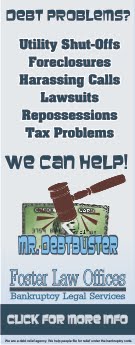According to an article in Honolulu's Star Advertisor... "Statewide bankruptcy filings were virtually flat in May, but there was a spike in Chapter 13, or so-called wage-earner, cases.
Total filings slipped 0.6 percent to 334 from 336 in the year-earlier period and marked the fourth time in five months this year that the number of cases had decreased from the same month in 2010, according to data released yesterday from the U.S. Bankruptcy Court, District of Hawaii.
For the year, the 1,567 cases filed are 5.1 percent lower than the 1,651 filings through May of last year.
There were no Chapter 11 reorganization filings by Hawaii businesses in May, though two businesses, Oahu-based B.J. Genz Plumbing LLC and Vision Communications Inc., which does business on Kauai as Kekaha Enterprises, filed for Chapter 7 liquidation.
While the number of Chapter 7 cases, which offer debt liquidation, dropped 10.4 percent in May from a year ago, the number of Chapter 13 filings shot up 40.9 percent, to 93 cases from 66 for the same period. One reason could be the number of homeowners "trying to save their home" from foreclosure, said bankruptcy attorney Edward Magauran.
"People are facing foreclosure and they're also at the same time racing to modify their mortgages under the HAMP (federal Home Affordable Modification Program), and they're not getting it done. Either the bank isn't taking them seriously and doesn't modify their mortgages, or foreclosure is breathing down their necks, so a lot of people will file a Chapter 13 to keep their real property," he said.
In such cases, filers can keep their real property, even if they are behind on payments, provided they make their regular monthly mortgage payments on time from and after the date of filing, and pay the Chapter 13 trustee a monthly amount to be disbursed to creditors, Magauran said. "The mortgage company then must treat you as being current, provided you do both of those things," giving filers the opportunity to attempt to complete a mortgage loan modification.
"The other absolutely, unbelievable, beautiful thing that you can do in a Chapter 13 that you cannot do in a 7, and we're seeing more of these, is lien stripping," he said. That practice strips a second mortgage from real property, as long as the homeowner owes more money on the first mortgage than the current fair market value of the property, Magauran said.
Other debts also may be restructured and partially discharged in Chapter 13 cases, Magauran said.
Some Chapter 13 filers probably should have filed under Chapter 7, said bankruptcy attorney Blake Goodman, but to some attorneys,"it's all about fees, to be extremely honest." A Chapter 13 case might cost an average of $4,000 to complete, while a Chapter 7 case can cost a filer between $1,200 and $1,500.
However, the "whole idea" behind the 2005 change in bankruptcy law was to "force more people into Chapter 13," so that more of their debt would be paid off, rather than discharged through Chapter 7 filings.
Given that, a Chapter 13 case is "a very powerful tool for a lot of things that a Chapter 7 cannot help with," said Goodman, who has represented bankruptcy clients in three states over 21 years.
The 93 Chapter 13 filings represent just under 28 percent of the May total, which Goodman believes underrepresents the "number of cases that should be filed to service the debt problems that are out there." A more realistic split between the types of personal bankruptcy filings is 40 percent Chapter 13 and 60 percent Chapter 7, he said.
In any event, Goodman's case load has somewhat lightened since last year when professionals in various industries were "lined up around my office," making his current outlook on the economy "very rosy" compared with a year ago.
Click Here to read the original article.

 11:35 AM
11:35 AM
 MrDebtBuster
MrDebtBuster
 Posted in
Posted in




0 comments:
Post a Comment